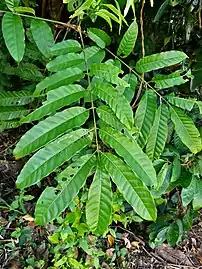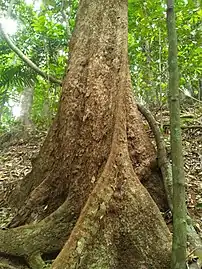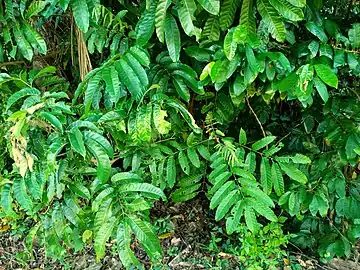| Spur mahogany | |
|---|---|
 | |
| Daintree National Park, Australia | |
| Scientific classification | |
| Kingdom: | Plantae |
| Clade: | Tracheophytes |
| Clade: | Angiosperms |
| Clade: | Eudicots |
| Clade: | Rosids |
| Order: | Sapindales |
| Family: | Meliaceae |
| Genus: | Dysoxylum |
| Species: | D. pettigrewianum |
| Binomial name | |
| Dysoxylum pettigrewianum | |
Dysoxylum pettigrewianum, commonly known as spur mahogany, spurwood, or Cairns satinwood, is a large tree in the family Meliaceae. It is native to the rainforests of Malesia, Papuasia and Queensland. In Queensland it occurs only in a small part of the northeast coast.
Description
The spur mahogany may reach in excess of 35 m (115 ft) tall, with a trunk to 1.2 m (4 ft) wide.[3][4] It is known for its tall, branched and wandering buttress roots, which can reach up to 2.5 m (8 ft) in height and extend up to 2 m (7 ft) from the trunk.[3] The rough flaky bark is brown with numerous lenticels.[3][5]
The large whorled leaves are imparipinnate with between 7 and 15 leaflets. They can reach up to 80 cm (31 in) long with a petiole up to 10 cm (4 in).[3] The petiole is sharply but very shortly winged and is swollen at its junction with the branch.[6] The leaflets vary in size, the proximal ones are relatively small and the distal ones larger. The terminal leaflet is the largest, measuring up to 20 by 6 cm (8 by 2 in).[3][6]
The inflorescences are racemes or spikes to about 19 cm (7.5 in) long, produced on the twigs (or rarely in the leaf axils).[3][4] Appearing in December and January, they carry numerous small fragrant flowers which are sessile and creamy white in colour.[3][4][6] The flowers have four linear to spathulate petals to 9 mm (0.35 in) long and a distinctive staminal tube (i.e. a tube made up of fused stamens) which is slightly flared at the tip.[3]
The fruits are a more or less pyriform capsule up to 45 mm (1.8 in) wide by 40 mm (1.6 in) long. They are dark brown on the outside with a warty appearance. At maturity they split to reveal the orange coloured interior with up to four seeds.[3][4][6]
Taxonomy
The species was first described by the colonial botanist of Queensland Frederick Manson Bailey, from specimens collected from "Scrubs at the base of Bellenden-Ker Range and the Barron River."[2][6] His description was published in Botany Bulletin. Department of Agriculture, Queensland 5: 9 in July 1892.[2][3]
Etymology
The species epithet was chosen by Bailey to honour the Brisbane businessman and politician William Pettigrew.[2][4] Bailey wrote: "After the Hon. William Pettigrew, who has always taken a deep interest in Queensland timbers."[2]
Distribution and habitat
In Australia Dysoxylum pettigrewianum grows in well developed rainforest from just north of Hope Vale to the Paluma Range, just north of Townsville. It is also found in the Maluku Islands, New Guinea, and the Solomon Islands.[3][7]
It is found at altitudes from near sea level up to 1,000 m (3,280 ft), reaching its best development in the lowlands on basalt soils.[3][6]
Ecology
The fruits are eaten by cassowaries (Casuarius spp.) who swallow the entire fruit, and by metallic starlings (Aplonis metallica), who extract and swallow just the seeds.[4][6][8] The leaves are eaten by Lumholtz's tree-kangaroo (Dendrolagus lumholtzi).[9]
The northern leaf-tailed gecko (Saltuarius cornutus) often hunts for prey in the scaly bark where it is well camouflaged.[5]
Conservation
This species is listed by the Queensland Department of Environment and Science as least concern.[1] As of 2 December 2022, it has not been assessed by the IUCN.
Uses
The timber of Dysoxylum pettigrewianum is classified as a hardwood, with a specific gravity of 865 kg/m3 (1,458.0 lb/cu yd).[10] It is red/brown in colour and is used as a general purpose and cabinet timber. It was once popular for boat building.[6]
Growing too large for the average garden, it is suitable for planting in parks and public gardens, making a useful shade tree. Young plants need shelter, and the species does best in a well-drained acidic soil.[11]
Gallery
 Compound leaf
Compound leaf Buttress roots and rough bark
Buttress roots and rough bark Base of the petiole
Base of the petiole Foliage
Foliage
References
- 1 2 "Species profile—Dysoxylum pettigrewianum". Queensland Department of Environment and Science. Queensland Government. Retrieved 3 December 2022.
- 1 2 3 4 5 "Dysoxylum pettigrewianum". Australian Plant Name Index (APNI). Centre for Plant Biodiversity Research, Australian Government. Retrieved 3 December 2022.
- 1 2 3 4 5 6 7 8 9 10 11 12 Mabberley, D.J. (2022). Sandgren, M.; Kodela, P.G. (eds.). "Dysoxylum pettigrewianum". Flora of Australia. Australian Biological Resources Study, Department of Agriculture, Water and the Environment: Canberra. Retrieved 3 December 2022.
- 1 2 3 4 5 6 Cooper, Wendy; Cooper, William T. (June 2004). Fruits of the Australian Tropical Rainforest. Clifton Hill, Victoria, Australia: Nokomis Editions. p. 290. ISBN 9780958174213.
- 1 2 "Rainforest Plants| Daintree Rainforest Discovery Centre". Daintree Discovery Centre. Retrieved 3 December 2022.
- 1 2 3 4 5 6 7 8 F.A.Zich; B.P.M.Hyland; T.Whiffen; R.A.Kerrigan (2020). "Dysoxylum pettigrewianum". Australian Tropical Rainforest Plants Edition 8 (RFK8). Centre for Australian National Biodiversity Research (CANBR), Australian Government. Retrieved 3 December 2022.
- ↑ "Search: species: Dysoxylum pettigrewianum | Occurrence records | The Australasian Virtual Herbarium". Australasian Virtual Herbarium. Council of Heads of Australasian Herbaria. Retrieved 3 December 2022.
- ↑ Beasley, John (2006) Plants of Tropical Queensland: the compact guide, Footloose Publications; page 104. ISBN 1-876617-13-6
- ↑ Martin, Roger William (2005). Tree-kangaroos of Australia and New Guinea. Collingwood, Victoria: CSIRO Publishing. p. 43. ISBN 0-643-09072-X.
- ↑ "Build with timbers summary |QTimber". QTimber. Queensland Government. Retrieved 3 December 2022.
- ↑ Elliot RW, Jones DL, Blake T (1984). Encyclopaedia of Australian Plants Suitable for Cultivation:Volume 3 - Ce-Er. Port Melbourne: Lothian Press. p. 377. ISBN 0-85091-167-2.
External links
 Data related to Dysoxylum pettigrewianum at Wikispecies
Data related to Dysoxylum pettigrewianum at Wikispecies Media related to Dysoxylum pettigrewianum at Wikimedia Commons
Media related to Dysoxylum pettigrewianum at Wikimedia Commons- View a map of historical sightings of this species at the Australasian Virtual Herbarium
- View observations of this species on iNaturalist
- View images of this species on Flickriver